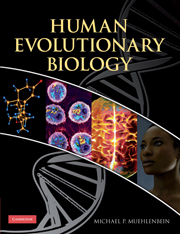Book contents
- Frontmatter
- Contents
- List of contributors
- Preface
- Part I Theory and Methods
- Part II Phenotypic and Genotypic Variation
- Part III Reproduction
- Part IV Growth and Development
- 22 Evolution of Human Growth
- 23 Variation in Human Growth Patterns due to Environmental Factors
- 24 Evolutionary Biology of Hormonal Responses to Social Challenges in the Human Child
- 25 Human Biology, Energetics, and the Human Brain
- 26 Embodied Capital and Extra-somatic Wealth in Human Evolution and Human History
- Part V Health and Disease
- Index
- References
25 - Human Biology, Energetics, and the Human Brain
Published online by Cambridge University Press: 05 August 2012
- Frontmatter
- Contents
- List of contributors
- Preface
- Part I Theory and Methods
- Part II Phenotypic and Genotypic Variation
- Part III Reproduction
- Part IV Growth and Development
- 22 Evolution of Human Growth
- 23 Variation in Human Growth Patterns due to Environmental Factors
- 24 Evolutionary Biology of Hormonal Responses to Social Challenges in the Human Child
- 25 Human Biology, Energetics, and the Human Brain
- 26 Embodied Capital and Extra-somatic Wealth in Human Evolution and Human History
- Part V Health and Disease
- Index
- References
Summary
INTRODUCTION
Human biology has made great progress in applying modern techniques to the understanding of human biological variation at the genetic, physiological, developmental, and phenotypic levels. For instance, rather than only asking about disease symptoms, human biologists measure immune makers which represent an underlying element of health (McDade et al., 2005; Muehlenbein et al., 2005; Snodgrass et al., 2007); rather than simply measuring body fat, they determine leptin levels as a signal of energy stores (Bribiescas, 2005). In addition to collecting self-reports of stress, they assay for salivary cortisol (Nepomnaschy et al., 2006; Pike and Williams, 2006). Along with collecting reproductive histories, they measure gonadal steroids including estrogen, progesterone (Lipson and Ellison, 1996), and testosterone (Campbell et al., 2006).
At the same time, human biologists have also become more evolutionarily sophisticated as they have adopted a life history perspective (Hill, 1993; Kuzawa, 2007). There is a growing understanding that much of the variation in the phases of the life cycle, starting in utero, and moving through childhood, adolescence, adulthood, and aging represents an inter-related response to energetic availability. The impact of nutrition during fetal development, in particular may have important implications for the rest of the life cycle (Jasienska et al., 2006; Kuzawa, 2007). Furthermore, the understanding that growth and development, immune function, and reproductive function are responsive to energetics means that human biologists can use energy as a currency through which the basic functions of growth, maintenance, and reproduction can be traded off (Hill, 1993).
- Type
- Chapter
- Information
- Human Evolutionary Biology , pp. 425 - 438Publisher: Cambridge University PressPrint publication year: 2010
References
- 10
- Cited by

